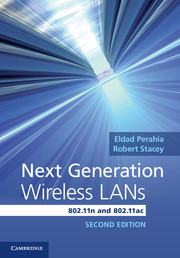Book contents
- Frontmatter
- Contents
- Foreword
- Preface to the first edition
- Preface to the second edition
- List of abbreviations
- Chapter 1 Introduction
- Part I Physical layer
- Chapter 2 Orthogonal frequency division multiplexing
- Chapter 3 MIMO/SDM basics
- Chapter 4 PHY interoperability with 11a/g legacy OFDM devices
- Chapter 5 High throughput
- Chapter 6 Robust performance
- Chapter 7 Very High Throughput PHY
- Part II Medium access control layer
- Part III Transmit beamforming, multi-user MIMO, and fast link adaptation
- Index
- References
Chapter 5 - High throughput
from Part I - Physical layer
Published online by Cambridge University Press: 05 June 2013
- Frontmatter
- Contents
- Foreword
- Preface to the first edition
- Preface to the second edition
- List of abbreviations
- Chapter 1 Introduction
- Part I Physical layer
- Chapter 2 Orthogonal frequency division multiplexing
- Chapter 3 MIMO/SDM basics
- Chapter 4 PHY interoperability with 11a/g legacy OFDM devices
- Chapter 5 High throughput
- Chapter 6 Robust performance
- Chapter 7 Very High Throughput PHY
- Part II Medium access control layer
- Part III Transmit beamforming, multi-user MIMO, and fast link adaptation
- Index
- References
Summary
The 802.11n standard is the high throughput amendment to the 802.11 standard. This section describes all the aspects of the physical layer which increase the data rate. MIMO/SDM is a key feature of 802.11n, which is discussed in Chapters 3 and 4. The other significant increase in data rate is derived from the new 40 MHz channel width. This section also discusses short guard interval, Greenfield preamble, and other modifications to the 20 MHz waveform.
40 MHz channel
In the last several years, regulatory domains have made much more spectrum available for unlicensed operation in the 5.47–5.725 GHz band for wireless local area networking. The addition of the new spectrum has more than doubled the number of available 20 MHz channels in the USA and Europe. Table 5.9 and Table 5.10 in Appendix 5.1 describe the current allocation in the USA and Europe, and the corresponding 802.11 channel number. Even with doubling the channel width to create 40 MHz channels, there are still more channels available for frequency re-use than in the early days of 802.11a. Furthermore, products currently in the market with proprietary 40 MHz modes have demonstrated that the cost for 40 MHz products is roughly the same as for 20 MHz products. Therefore, with free spectrum and relatively no increase in hardware cost, doubling the channel bandwidth is the simplest and most cost effective way to increase data rate.
- Type
- Chapter
- Information
- Next Generation Wireless LANs802.11n and 802.11ac, pp. 105 - 146Publisher: Cambridge University PressPrint publication year: 2013



